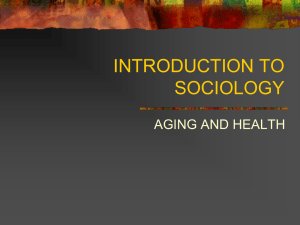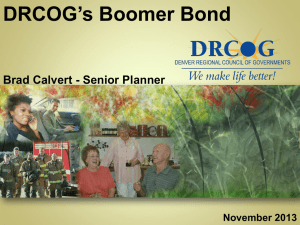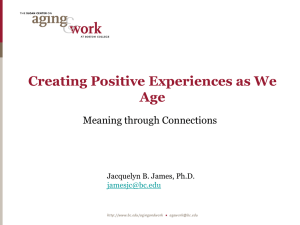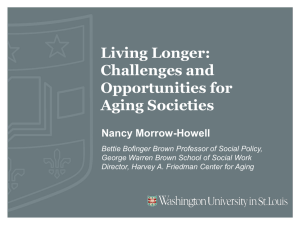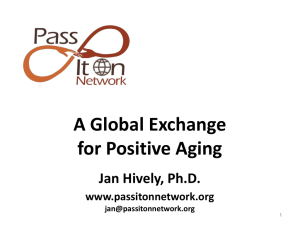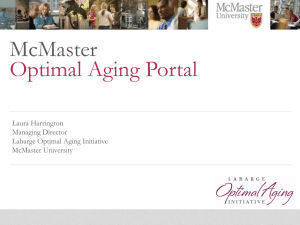Gerontology and Aging
advertisement
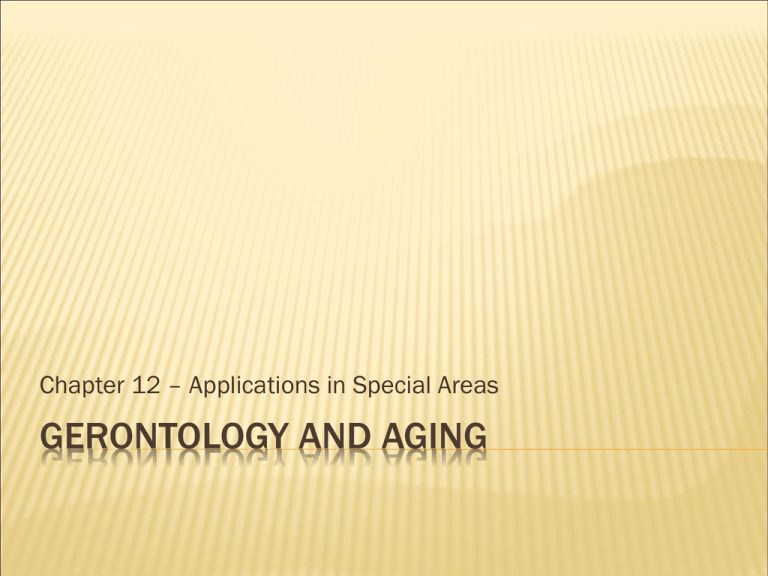
Chapter 12 – Applications in Special Areas GERONTOLOGY AND AGING INTRODUCTION Older adulthood an important stage Human service workers are called on to help We will explore gerontology, aging and ageism We will explore myths and theories We will look at trends We will discuss settings, values and roles in the provision of human services GERONTOLOGY Defined as the study of the physical, mental, and social processes of growing older. Comes from the word “geron” which means “aging” and logos, which means “knowledge.” Relatively new field of study – last 50 years Note: Geriatrics is a subset of gerontology and is the field of medicine that pertains to the diseases and treatment of older persons. SOCIAL CHANGES US statistics In 1900 people over the age of 65 were 4% In 1990 13% People are living longer AGING Aging is the way humans move along the continuum of time. There are three important things to remember. 1. 2. 3. Aging describes the normal progressive changes that can be expected in cells, organs, biological systems, etc. Aging is an individual process, no two people age the same Within one person, systems and organs age at different paces WAYS AGING CAN BE DESCRIBED AND STUDIED 1. 2. Chronological – number of years lived Bureaucratic – eligibility for social programs or services, such as 3. 4. 5. 6. 7. 65 for Social Security 55 for discounts in stores Functioning – mobility, ability to care for oneself, and overall health. Social – roles and relationships in the social structure as people age. Biological – physical changes to organs and cells Psychological – sensory and mental functioning, personality, attitude and coping. Demographic – the trends in the overall and aging population. THINGS THAT AFFECT A PERSON’S PATH TO AGING Heredity Occupation Environment Stress Health care Health maintenance Level of activity QUESTIONS Provide an example for the myths. Think of someone or tell a story of someone you know that does not follow the myth. INTERESTING GROUPINGS 0 – 21 years – childhood and adolescence 21 years 20 – 60 - approximately 40 years 60 + - can be 10 – 30 years Subcategories might be good Young old (approximately 60 – 74) Middle old (approximately 75 – 80) Old old (usually over 85) Interesting that people from different generations may attend the same seniors group. The most rapidly aging group is 85 and over and 70% are females and many of these are disadvantaged as they were not part of the working force. AGEISM This word was coined by Robert Butler Prejudice based on age Ageism is prejudging an individual, a group of people, or a physical condition based on preconceived notions of age. Ageism causes us to assume things about persons based solely on their age. Ageism includes discrimination based on age. Ageism is fueled by our society’s worship of youth and physical beauty and predominance of the work ethic. EXAMPLES OF AGEISM – COME UP WITH SEVEN MYTHS ABOUT AGING All older people are alike Older people cannot learn Older people are senile All older people are in Nursing Homes All older persons are sick and helpless Older persons become more religious as they age. Older age is a “Golden Age.” MYTH #1 - ALL OLDER PEOPLE ARE ALIKE Examples might be “All old people are sweet” “All old people are crotchety and grouchy.” People grow more like each other as they age TRUTH IS …We retain our unique personality and cultural characteristics as we age. Personalities get more distinct and unique. MYTH #2 – OLDER PEOPLE CANNOT LEARN “You can’t teach an old dog new tricks.” TRUTH IS … Older persons learn at a slower pace, but they do learn, and they do retain the information. The ability to learn will not stop unless there is a medical problem. MYTH # 3 – OLDER PEOPLE ARE SENILE “Senility” is inevitable Senility is mistakenly used to describe dementia, mental impairment, and memory loss; however, “senility” is actually just a synonym for “old” and does not mean mental impairment TRUTH IS … Mental deterioration is neither normal or inevitable. The majority of the population do not develop dementia. MYTH #4 – ALL OLDER PERSONS ARE IN NURSING HOMES TRUTH IS … Approximately 85% of persons over 65 are in their own homes, living on their own and doing well. MYTH # 5 – ALL OLDER PERSONS ARE SICK AND HELPLESS Some think older persons lose their sexuality Older persons cannot benefit from mental health services All older persons are physically impaired or ill. TRUTH IS … Each person is different, of course, but in normal aging, generally none of the stereotypes above are true MYTH # 6 – OLDER PERSONS BECOME MORE RELIGIOUS AS THEY AGE TRUTH IS … People who are old and religious were young and religious. Spiritual attitudes tend to remain constant throughout life, but religious activities may decline in later adulthood due to mobility problems, transportation problems, sensory impairments, or health problems. MYTH # 7 – OLDEN AGE IS A “GOLDEN AGE” Some think that retirement age is always tranquil and untroubled TRUTH IS …. Some face decreased income, increased isolation, chronic illnesses and conditions, substandard medical care, and fear of losing one’s independence and home. Some elders are faced with ageism, sexism, classism, racism, xenophobia (hatred or fear of foreigners or strangers or of their politics or culture,) etc. QUESTIONS TO THINK ABOUT ??? 1. 2. 3. The myths discussed are very common. Which ideas had you held about what aging would be like? Discuss how media images and societal stereotypes can perpetuate these myths. Watch a movie that portrays older people. Identify ways these films perpetuate myths about aging. ABC News – Myth busting longevity http://abcnews.go.com/GMA/Books/video/f orever-young-myth-busting-longevity13084023 TRUTH ABOUT AGING … Neither all good nor all bad Mixture of gains and declines Later years are not necessarily a “golden age,” neither is it a hellish existence with no joy Aging is an individual event as well as a condition that is heavily influenced by societal attitudes and support. Older people are widely different from each other and their experiences cannot be generalized. SOCIAL THEORIES OF AGING 1. 2. 3. 4. 5. Disengagement theory Activity theory Continuity theory Psychological model Role theory A theory is a particular view of the world and a way of putting on a different set of lenses. BENEFITS OF A DIFFERENT THEORIES Judge what fits your perspective 2. Can be aware of different ways of interpreting aging 3. Can pick and choose parts of theories to form your own truths This means that no one view of the world is written in stone and that no one perception may be right or wrong. We must consider facts and experience. 1. #1 - DISENGAGEMENT THEORY Developed in 1961 Says people remove themselves from society as they age and society eases away from them Theory says that older persons are inactive and withdrawn Says elders do not need to be active Considers it is normal, adaptive and natural for older persons and society to withdraw from each other Example: It is considered functional for society to transfer power and responsibility to younger persons, and for older persons to remove themselves from the workplace. #2 - ACTIVITY THEORY Developed in 1961 as a reaction against disengagement theory Says that old age is no different from middle age Persons who are active will be more satisfied and better adjusted than those who have disengaged. This theory is congruent with societal values about work and productivity. #3 - CONTINUITY THEORY Theory 1968 Takes into account the course of an individual’s life and states that personality and styles of coping do not change with age. The aging person changes roles but continues to adapt as he or she always has Personality is the major factor in adjustment People as they age become more and more like what they were when they were young. #4 - PSYCHOLOGICAL MODEL Is based on a life cycle view and theories of human development States later adulthood is a life stage of its own Life is a continuum of change and growth Each stage has its own unique problems, tasks, coping skills, crises, and potential The psychosocial task of older adulthood is this theory is called “integrity versus despair,” meaning that a person who is facing the end of his or her life must come to terms with what he or she has been able to be and do throughout life. #5 - ROLE THEORY Theory from 1942 People hold a variety of roles and relationships through their lives, such as spouse, parent, sibling, employee, and friend. Roles determine our self-concepts and our selfimages Age alters roles, norms, standards, and expectations. #5 ROLE THEORY (CONT’D) Examples: A woman who is 75 who has defined herself primarily as a wife for 50 years will have a difficult adjustment upon widowhood, in addition to experience the grief from losing a husband. A man of 65 who has defined himself for his adult life as primary breadwinner and as employee will perhaps have a difficult time adjusting to forced retirement. QUESTIONS 1. 2. 3. Social theories of aging focus on different aspects of aging; for example, social involvement, personal adjustment, or personality style. Which ideas help us to understand which aspect of aging best? Which theory best fits with your own view of aging and explain your choice. How might human service work with older persons be influenced by a belief in each of the above theories? QUESTIONS 1. 2. 3. Social theories focus attention on different aspects of aging; for example, social involvement, personal adjustment, or personality style. Which ideas help us to understand which aspect of aging best? Which of the above theories fits best with your own view of aging? How might human services work with older persons be influenced by a belief in each of the above theories?

